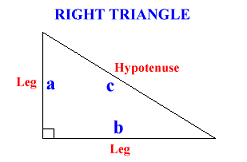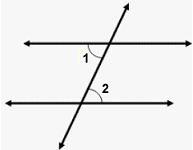Angles Within a Rectangle
|
Our SAT ACT Math Prep software program contains over 35 topic areas. One of them is
Angles Within a Rectangle, and this page summarizes the main ideas of this topic. This page is intended for review, and is not a substitute for the interactive, self-paced tutorials of the MathTutor SAT ACT Math prep program.
|
General Explanation
Here are some important facts to know about right triangles:
- A right triangle is a triangle in which one of the angles is 90 degrees. Look at the right triangle below:

According to the Pythagorean Theorem, the three sides are related as follows:

- Here are some facts about angles of right triangles:
- In a right triangle with angles of 45, 45, and 90 degrees, the two sides are of equal length.
- Finally, consider two parallel lines intersected by a diagonal line, called a transversal, below. Angle 1 and angle 2 are called
alternate interior angles, and Angle 1 = Angle 2.

Sample Problem
You are a given a rectangle ABCD with diagonals AC and BD. The diagonals intersect at Point E and CD has length 1.
If angle BAC = 45 degrees, then what is the area of triangle CDE?
Solution
Angles DCA and BAC are alternate interior angles, and therefore are equal. Since angle BAC = 45 degrees, then angle DCA = 45 degrees.
Since angle DCA = 45 degrees and CD = 1, then it follows that AD = 1 and AC = √2.
Since the diagonals bisect each other, CE = 1/2 * CA = 1/2 * 2.
It can be shown that the area of triangle CDE is 1/2 the area of triangle ADC. Therefore:
Area of triangle CDE = 1/2 * area of triangle ACD
= 1/2 * 1/2 * base * height
= 1/2 * 1/2 * length of CD * length of AD
= 1/2 * 1/2 * 1 * 1
= 1/4
|





